In Northern China

Chapter V of Immanuel Velikovsky’s Earth in Upheaval is entitled Tidal Wave. The six sections of this chapter review the scientific evidence for catastrophic floods and mega-tsunamis in the Earth’s recent past. The fourth section, In Northern China, documents Chinese bone caves similar to the one discovered in Cumberland, Maryland, which Velikovsky discussed in the previous section.
The caves are located near Choukoutien (Zhoukoudian), a suburb on the southwestern outskirts of Beijing. It was here in 1921 that the hominid remains known as Peking Man were first discovered. These have been subsequently identified as fossils of Homo erectus. There is no consensus on the age of the hominid remains at Zhoukoudian, with estimates varying from as little as 200,000 years ago to as much as 800,000 years ago. Much younger fossils of Homo sapiens have also been discovered here.
In addition to the Peking Man Site, more than twenty other fossiliferous sites have been discovered and excavated at Zhoukoudian. These include the Upper Cave, which is believed to have been inhabited by modern humans between 10,000 and 20,000 years ago. Tools and ornaments made of stone and bone were also discovered here, and the remains of many animals.
Several of the sites date back to the Middle and Late Pleistocene Ages, and contain fossils of many mammalian species: porcupine, raccoon dog, badger, sabre-toothed tiger, giant deer, jackal, macaque, pig, bear, horse, civet, bamboo rat, woolly rhinoceros, and gazelle. Fish and bird fossils have also been discovered, of both extinct and extant species.
It is thought that the caves were inhabited by Homo erectus during the Pleistocene Epoch, before being rediscovered and occupied by Homo sapiens during the Upper Palaeolithic. According to this scenario, the caves were abandoned for almost 200,000 years, if not longer.

Franz Weidenreich
Among the anthropologists who carried out excavations at Zhoukoudian, Velikovsky is particularly interested in the findings of the German anatomist Franz Weidenreich. In 1935 he succeeded Canadian paleoanthropologist Davidson Black as honorary director of the Cenozoic Research Laboratory of the Geological Survey of China. In this capacity, Weidenreich continued the excavations which Black had begun eight years earlier. In 1937, the Japanese invasion of China brought these excavations to an end. About 200 human fossils from more than 40 individuals had been recovered, as well as a wealth of animal fossils from 200 different species. In 1941 the bulk of these remains were lost while being transported to a safer location. Fortunately, Weidenreich had made copies of all the fossils and these have survived.
Weidenreich originated the “Weidenreich Theory of Human Evolution”, a polycentric model of human evolution based on his examination of the fossils of Peking Man. Being a qualified anatomist, he observed numerous anatomical characteristics that Peking Man had in common with the Han population of modern China.
Weidenreich was one of the anthropologists who rejected the authenticity of the Piltdown Man fossils:
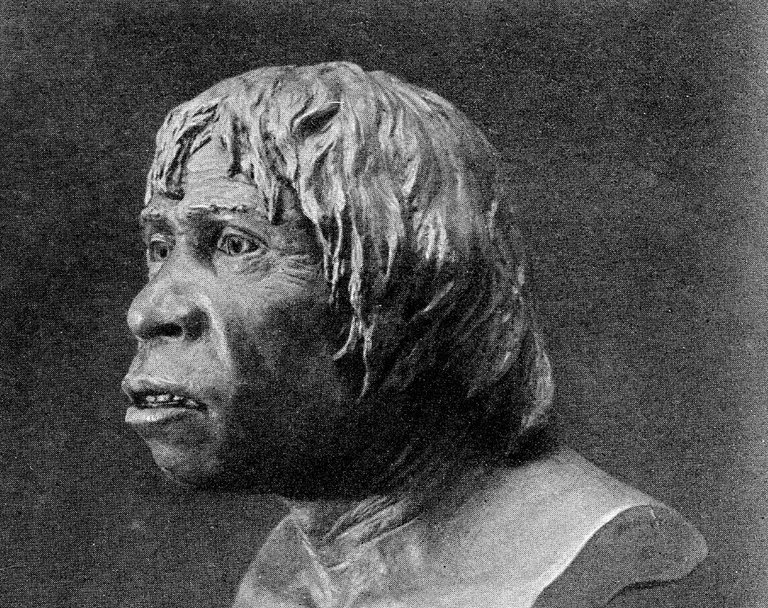
Vallois (1949) criticized Weidenreich for not accepting Piltdown as an early Pleistocene ancestor of modern man, and Keith (1949: 229) remarks, “A leading authority on such problems, Dr. Franz Weidenreich, has recently proposed that the right solution is to deny the authenticity of the Piltdown fossil remains. Here are his exact words: ‘Eoanthropus should be erased from the list of human fossils. It is the artificial combination of fragments of a modern-human braincase with orang-utang-like mandible and teeth.’ That is one way of getting rid of facts which do not fit into a preconceived theory ...” In retrospect it is not so easy to say what was “fact” and what was “preconceived theory.” (Washburn 436)
History has confirmed Weidenreich’s anatomical assessment of the Piltdown fossils.
In 1941, Weidenreich began to work for the American Museum of Natural History in New York. It was in that city that Franz Weidenreich died in 1948, at the age of 75.
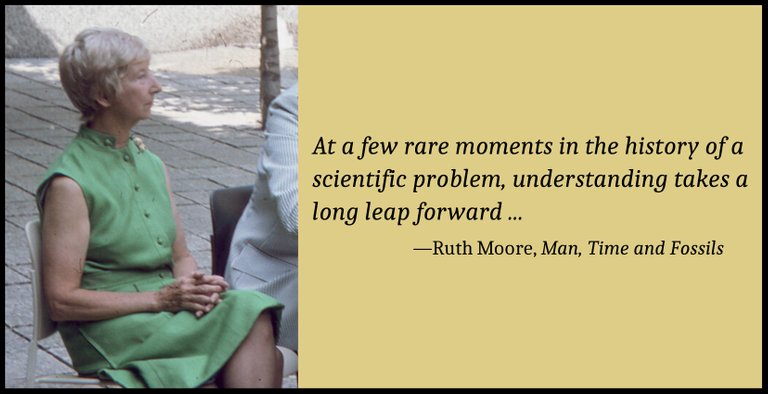
In this section, Velikovsky draws on Ruth Moore’s history of evolutionary theory as it applies to mankind, Man, Time and Fossils: The Story of Evolution, which appeared in 1953. Also known by her married name Ruth Moore Garbe, she was born in St Louis in 1908. Moore was a journalist with the Chicago Sun-Times for twenty years (1950-70), but is best known today as a writer of popular books on science. Her Man, Time and Fossils was a bestseller. She died in San Francisco in 1989 at the age of 80.
Chapter 14 of Man, Time and Fossils is entitled: “Black and Weidenreich. China: The Discovery and Disappearance of Peking Man”.
Evolution or Revolution?
What most astonished Weidenreich about Zhoukoudian was the wealth of bones found in the caves:
From the stacks of bones about, it looked as though Peking man ate well. And venison must have been his favourite meat—more than seventy-five per cent of the fossil bones were those of the deer. But there were also bones of the wild boar, the bighorn sheep, the mammoth, the camel, the bison, the ostrich, and of such river-dwellers as the otter and the water-buffalo. And all the mammalian bones differed from those of living species. All were types that had long since vanished from the earth. (Moore 252)

A similar wealth of animal bones was discovered in another cave—Upper Cave—one which had been inhabited much more recently:
Dragon-bone Hill was to afford another glimpse of man making his way along the long road to civilization. Many ages after Peking man had vanished from the Western Hills, another group of men moved into another cave in Dragon-bone Hill. It seems probable that this cave was not accessible during the time of Sinanthropus, but was dissolved out of the limestone many thousands of years later ...
But an unimaginable wealth of fossil animal bones nearly filled the cave. Piled everywhere were the bones of thousands of hares, thousands of the complete lower jaws of Sika deer, and hundreds of whole skeletons of other deer, tigers, bears, hyenas, and ostriches. The hyenas, bears, and ostriches represented forms long since extinct, while the tiger and some of the others had disappeared from that part of Asia.
The cave and its violently murdered tenants seemed to belong to the period the geologists designate as Upper Palaeolithic. It corresponded roughly to a culture that then was believed to have flourished in Europe between 20,000 and 100,000 years ago. (Moore 253)
But there were more surprises, and it is here that the plot thickens:
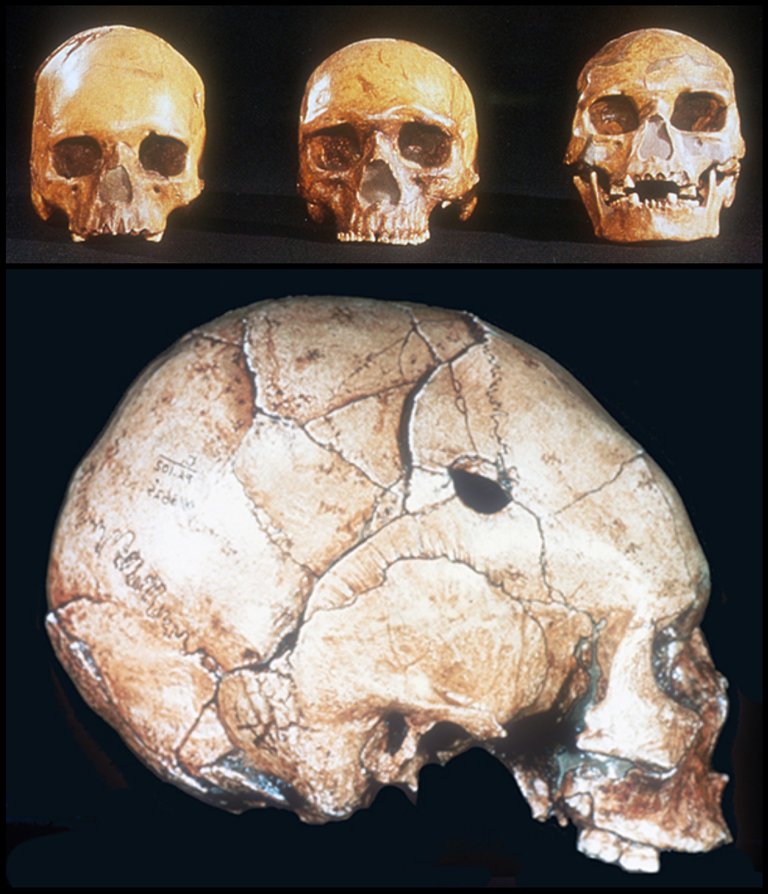
As Weidenreich began his studies, other amazing, nearly unexplainable features appeared. The skull of the old man looked something like that of a European—a primitive European, of course. One of the women, on the other hand, had a narrow head, remarkably similar to that of the Melanesians of New Guinea. Another peculiarity stumped the anthropologist. Across the forehead was a broad and shallow circular depression, a deformity that had nothing to do with the crushing blows that had killed her. Similar depressions are seen even in comparatively modern times in the skulls of women who carry heavy burdens by a strap running across the forehead.
As though enough problems had not been posed, the skull of the other woman displayed many of the distinctive traits of the modern Eskimo type.
A European, a Melanesian, and an Eskimo type lying dead together in a cave on a Chinese hillside! Weidenreich marvelled. (Moore 253)
Weidenreich was forced to undergo some mental gymnastics in order to account for this anomaly without abandoning his Uniformitarian beliefs:
After long study and investigation the anthropologist ventured the opinion that man may have split into different racial stems in even so early a stage of evolution as that represented by Pithecanthropus and Sinanthropus. He was convinced, though, that this held true only for the main races. He theorized that each of the latter might later have divided into sub-races, originating as mere individual variations. ‘If this is true the presence of three “racial” types in one and the same family is easy to understand,’ said Weidenreich. (Moore 253-254)
This is preposterous. Even today, if one were to find a European, a Melanesian and an Inuit in the same family, one would naturally assume that at least two of them were adopted.
As we saw in the preceding article, Velikovsky believed that the bones discovered in the Cumberland Bone Cave were deposited there by flood waters. But he does not insist that the bones discovered in the Upper Cave were of a similar provenance. He suggests, instead, that the humans whose remains were found there fled to the cave in search of shelter from some catastrophe:
It is possible that these several types of man came together in Choukoutien, since the migrations of ancient man were on a greater scale than is generally thought. (Velikovsky 56)
This hypothesis, however, does not apply to the earlier bone deposits—the ones associated with the remains of Peking Man. Here, the tale told by the bones is similar to that told by those found in the Cumberland Bone Cave.

J S Lee
Li Siguang, or Li Zhongkuei, was a Chinese geologist and politician of Mongol extraction. He is sometimes known in English as J S Lee. Between 1904 and 1910 he studied shipbuilding at Osaka University in Japan. And between 1913 and 1918, he studied mathematics, astronomy, physics and geology at Birmingham University, England. After his return to China in 1920, he taught geology at several universities and was an active researcher in the field in several parts of the country. In the 1950s, after the establishment of the People’s Republic of China, he was Vice President of the Chinese Academy of Sciences and the Minister of Geology.
His English textbook The Geology of China was published in London in 1939, having grown out of a series of lectures he gave at various British universities in 1934-35. It is from this book that Velikovsky takes the remaining citations in this section. Curiously, however, his first quotation—“in a strange mixture”—is a misquotation, and is not referenced. This exact phrase does not occur in either Moore or Lee, but on page 369 of Lee’s Geology we read (my emphasis):
Turning to the faunal aspect, reference may well be made to the unusually rich deposit in the fissures of Choukoutien, occurring in association with Sinanthropus. This fissure deposit has been assigned on reasonable grounds to the early part of the Choukoutien Stage [Early Pleistocene]. The fauna that it yields is a strange mixture. In an attempt to evaluate their climatic significance a few forms out of each group are here tabulated according to their accepted habitat: (Lee 369)

Lee then divides the animal species found in association with Peking Man into three broad groups:
Animals of Tundral Habit
Sub-Arctic Steppe Forms
Animals Which Lived in Temperate Climates
The first group includes the woolly rhinoceros and the wolverine. The second group includes several species of wild dog, rodent, sheep, weasel, badger, vole, deer and antelope. The third group includes Merck’s rhinoceros, pig, giant beaver, hyena, otter, saber-toothed cat, macaque and buffalo.
Lee, a uniformitarian, is perplexed by this assemblage:
It will be seen that no conclusive evidence can be derived from this faunal assemblage as regards the prevailing temperature at the time when it lived. The occurrence of Rhinoceros tichorhinus, together with numerous other animals that usually subsist in cold regions, would seem to indicate a rather severe climate. And some of these are among the typical elements of the fauna of the Ice Age in Europe. They are, however, associated with buffaloes and other animals of a warm climate. In the case of the woolly rhinoceros (Rhinoceros tichorhinus), which is taken to be the characteristic tundral fossil of the Great Ice Age in Europe, we find its remains among the Sanmen fauna and in the later Pleistocene deposit near Harbin where it is associated with buffaloes and mammoths. The deposit near Harbin is evidently contemporaneous with the Malan Loess of northern China. In the Malan Loess fossil ostriches and buffaloes are also found. It is almost inconceivable that animals like the buffalo could endure a climate under which the mammoth existed; and yet their remains are found side by side. (Lee 370)
The only reasonable explanation is that these bones were transported here by megafloods from many different and distant parts of the globe, before being deposited together in the caverns of Zhoukoudian.
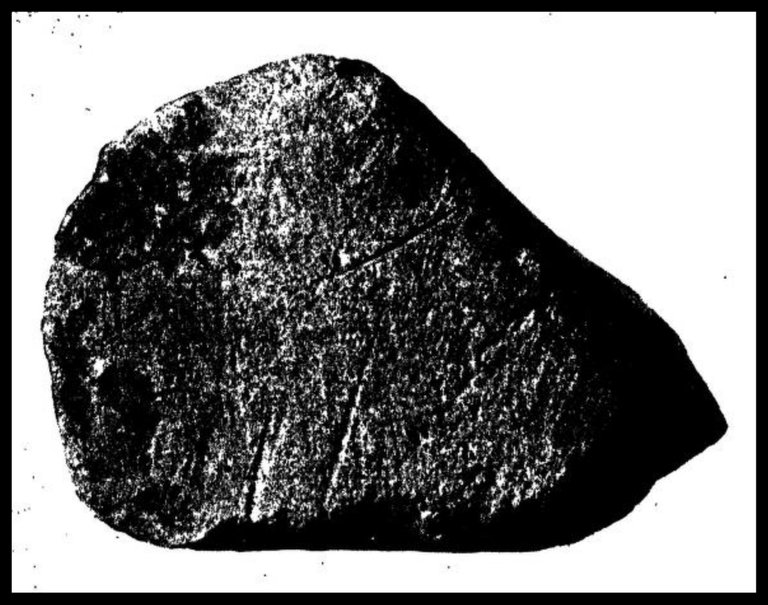
Erratic Boulders
A similar anomaly is presented by the occurrence of erratic boulders in Northern China. Although the Laurentide Ice Sheet of North America covered most of Canada and reached as far south as 40° N latitude, there is no evidence that the northern reaches of China—53.56° N—were ever glaciated during the Pleistocene. On the other hand, there are certain facts which seem to imply glaciation:
It would thus seem that ever since late Pliocene times northern China went through periodic and perhaps progressive desiccation interrupted by pluvial intervals. No room would seem to be left on the chronological scale for any violent change of climate except for the time immediately before the deposition of the Red Loams (or soon after their deposition), if the significance of their coloration be rightly inferred by Teilhard de Chardin and Young. Barbour’s deduction for gentle climatic fluctuations from cool and dry to warm and humid seems to be the most natural as far as the ascertained facts go.
On the other hand, certain obscure facts not in agreement with the foregoing interpretation are accumulating throughout the country. They demand an explanation in accordance with known geological processes and in harmony with the established climatological history of eastern Asia. In bringing out such obscure facts the writer wishes to emphasize certain neglected details. Before such details can be satisfactorily explained on the basis of the prevailing view, it would be harsh to rule out one possibility, namely, local glaciation. Explanations in general terms can hardly be of any use in our discussion; for such an attempt is liable to prejudice the case in hand or even to cause confusion. Specific explanation must be sought for in each particular case. (Lee 371)
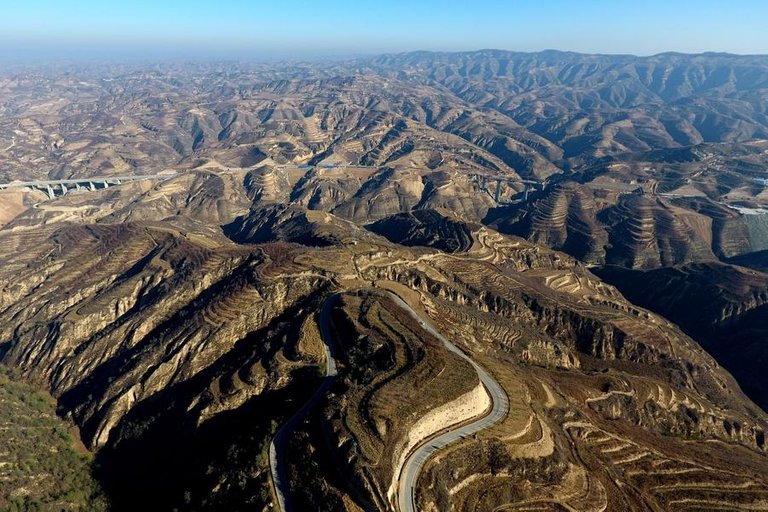
One such “obscure fact” is the embarrassing presence of erratic boulders and striated rocks in Northern China:
From the accounts, not altogether reliable, given by travellers in northern China regarding the occurrence of erratics, James Geikie discussed a probable glaciation of that country in his treatise on the Great Ice Age. More than a decade ago large angular blocks of gneisses and schists were found in the Tatung Basin, northern Shansi, in association with local debris in some of the valleys. The floor of that basin, some thirty to forty miles [~50-60 km] wide, is everywhere composed of Jurassic sandstones and conglomerates. It is separated by a broad valley from the high mountains on the west, whence the erratic blocks probably came. In association with the gneissic blocks occasionally occur planed and scratched subangular boulders with several sets of striæ that, as far as the writer is able to judge, cannot be merely slickensides or scratches due to surface creep.
Large and small erratics have been noticed on the tops of a number of isolated hills among the Western Hills of Peking. On account of their position of occurrence, they are generally regarded as of Pontian or Lower Pliocene age. It must, however, be noted that apart from those cases in which stratigraphical and palaeontological evidence is available, the Pliocene age of the boulders is by no means established. One such erratic block, lying in the Plain of Peking at a point about 7 km from the foot of the Western Hills, weighs some 15 tons. This block is composed of the Chiulungshan Conglomerate of Cretaceous age. We know, therefore, where it came from and that it has travelled for more than 7 km across the plain. Judged from its jagged shape and solitary occurrence, no conceivable reason can be suggested for its transport by human agency. The question remains as to how it became removed from the bed-rock to such a distance, unless it were by ice. (Lee 371-373)
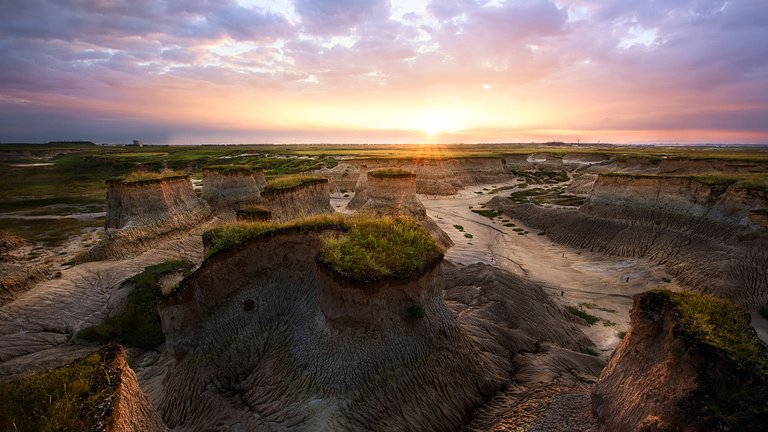
Although there is evidence of glaciation on the tops of the mountains, many of the erratics, striated rocks and deposits of boulder clay are lowlying:
Still more suspicious are the features on the top of the Tapeishan in the northern part of the western Tsinling (about long. 107° 40' E., lat. 33° 55' N.). The top of this mountain reaches 3,300 m above sea level, and 2,700 m above the plain on the north. There exist five small tarns on the top of the mountain, each having a circumference of from 330 m to 430 m as measured on the surface of the water, and each has a U-shaped outlet. Under present climatic conditions the water in the tarns only begins to freeze on the surface during the winter season. These tarns are carved out of a granite. They cannot, therefore, be “sinkholes” such as often occur in limestone mountains. These features would seem to indicate the existence in recent times of mountain glaciers, perhaps of small size. But they do not throw much light on the main problem at issue; for the suspected erratics and boulder-clay-like deposits attain a much more extensive development in the low ground and are obviously older. (Lee 374)
The Qinling Mountains lie at 33° N, approximately the same latitude as Casablanca in North Africa. Northern Shansi is around 41° N, the latitude of Madrid. How could lowlying regions at such latitudes have been glaciated during the Pleistocene? This is evidence of either megafloods or catastrophic crustal displacement.
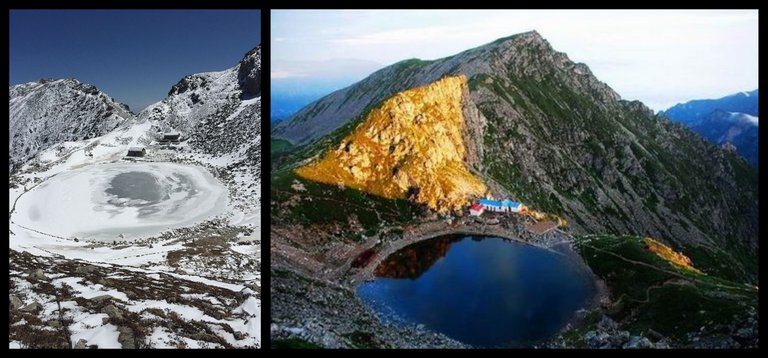
Mountain Building
J S Lee was no catastrophist, but some of the views he expresses in The Geology of China are surprising coming from a mainstream geologist. In particular, he believed that significant uplift has occurred in some Chinese mountain ranges during the recent Glacial Age:
Among the most striking changes that have taken place in China during recent geological times is the regional uplifting and subsidence that have been recognized in different areas. The evidence gathered, though it still requires careful co-ordination, is nevertheless conclusive as regards a general movement ... In the mountainous region of western China nearly all observers agree that rapid uplifting has been going on. The Kinshakiang, with its north-south tributaries now forming the headwaters of the Yangtze, is believed to have drained its waters to the south through the present watershed in northern Yunnan. The lowest point of this watershed at Tsinpukou [Kinpukou, near the First Bend of the Yangtze River], or the wind-gap of Gregory, is about 600 m high above the present river. Gregory assumed that this was the gap through which the Kinshakiang formerly ran southward to join the present Red River. Lee, however, considers it more probable that the ancient river course followed a series of raised open valleys leading from the north to the south past the Erh-hai, and then entered into the Red River Valley. It is of interest to note that the lakes situated in these elevated north-south valleys are all of a comparable height, about 2,300 m in altitude. The highest saddle reaches 2,612 m If the Kinshakiang actually followed this course in early Pleistocene or Plio-Pleistocene time, Deprat’s estimation of elevation of 2,000 m in that area since early Pleistocene time would hardly seem to be an exaggeration. (Lee 205 ... 206)

Lee also believes that significant elevation has also taken place since the Glacial Age:
There is clear evidence that the glaciers in the high mountains have retreated considerably in recent geological time. The argument that such stream erosion might be due to increased precipitation in post-glacial time can therefore be safely ruled out. Thus we may agree with Heim that the mountain ranges in western China have been elevated since the glacial age. Similar evidence of recent uplifting is available in the Himalaya. It would seem probable that the Tibetan massif, with the lofty height that it has already attained, is still undergoing elevation. (Lee 207)
There is also evidence of recent subsidence:
At Tientsin, marine sands and clays with Arca, Cyclina, Siliquaria and Mactra have been found in an artificial exposure at a level of about the Taku Datum. Boreholes made in the same city showed the presence of sands and clays with fresh-water shells down to a depth of more than 507 feet [155 m] below the marine layer which is exposed on the surface. This is undoubtedly due to recent subsidence. (Lee 206)
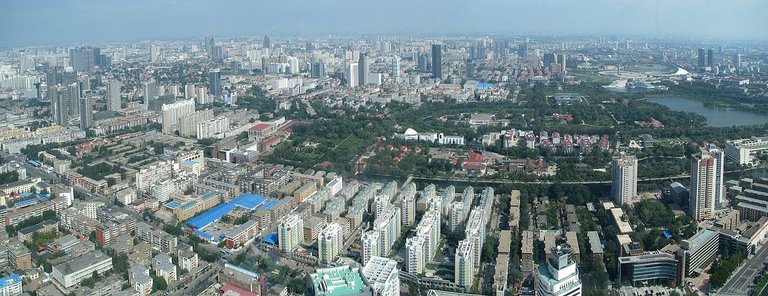
Velikovsky suggests that this surface marine layer is evidence of the megaflood that deposited the animal bones in the cave system of Zhoukoudian:
Was not the irrupted sea the agent that threw together the animals of various latitudes and carried rocks of foreign origin to the tops of hills? Did not the mountains that sprang up in the age of man rise in the upheaval that also moved the seas out of their borders? (Velikovsky 57-58)
Red Loam
The final question explored in this section is that of the red loam characteristic of the North China Plain:
Now we come to the Fourth Cycle as recognized in northern China. This cycle also began with an extensive erosion which was accompanied or followed by deposition in caves or fissures in which the early man, Sinanthropus pekinensis, made his home ... It is generally held that the Red and Reddish Loams, which occur so extensively in northern China with Siphneus fontanieri as the characteristic fossil, also belong to the Choukoutien Stage. (Lee 202)
Loam is a mixture of sand, silt and clay—typically in a ratio of about 2 : 2 : 1 by mass. The red loam of northern China is believed to have been deposited during the so-called Choukoutien Stage, or Early Pleistocene. The reddish colour of this loam is of uncertain provenance:
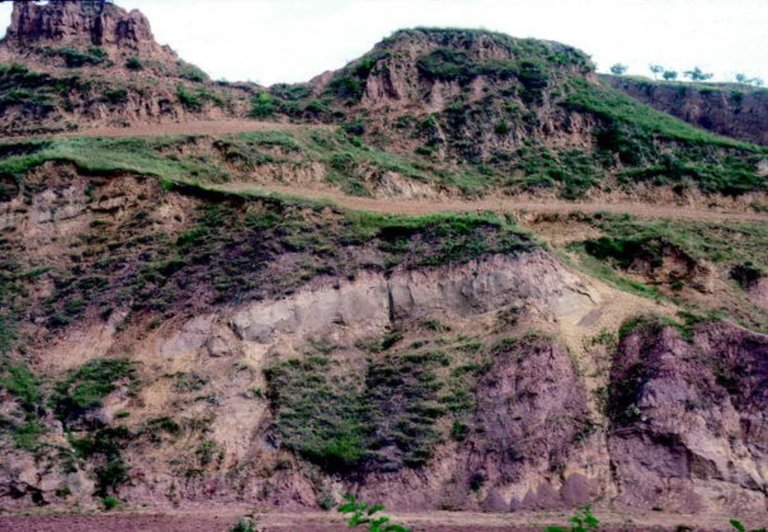
The Sanmen Series of northern China is generally unconformably overlain by a Red Loam which in places contains coarse basal gravels or conglomerates. In the Taiku Basin, where Barbour describes a classical section of the young formations, the Red Loam cuts into the violet sands which form the middle part of the Taiku Beds, indicating an interval of erosion between the late Pliocene and the deposition of the Red Loam. The latter, together with its overlying Reddish Loam, is generally correlated with the Choukoutien Stage, which is of early Pleistocene age and which signals the appearance of Peking Man. Several observers agree in establishing the relative stratigraphical position of this red loamy material. The accounts given by Barbour and by Teilhard de Chardin and Young are particularly illuminating as to its climatic significance. The loessic nature of the material and the limy concretions that it frequently contains would certainly seem to point to deposition under arid conditions. From their observations in Central Shansi and elsewhere, Teilhard and Young conclude that the coloration of the red loams in northern China can neither be a quality inherited from the original material of which the loams are composed, nor a condition brought about by slow chemical processes long after their formation. They believe that at first some climatic conditions responsible for the chemical alteration of the loams must have prevailed, but that later the climate changed until the Malan Loess was deposited. They are also of opinion that tropical regions would probably supply the conditions required. (Lee 368-369)
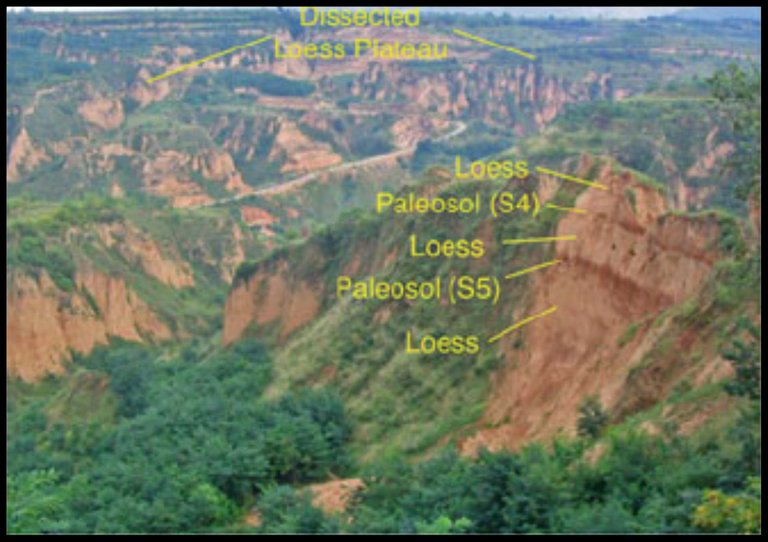
It is still a matter of scholarly debate whether the red loam is loess:
The question arises as to whether these deposits should be referred to as loess. Among engineers and in popular parlance they have gone by this name for so long that a situation has developed analogous to that regarding the use of the term laterite. If the word loess is to be allowed to include these loessic loams then care must be taken to distinguish the Malan loess from these older, partially altered Sanmen loess deposits. (Barbour 56)
The relationship of the red loam to China’s extensive deposits of yellow loess complicates things. In the North China Plain, the red loam of the Choukoutien Stage is overlain with yellow Malan Loess, which was deposited in the Late Pleistocene. Conventionally, loess is believed to be of aeolian origin—wind blown. Some catastrophists, however, believe that it was deposited by megafloods. In Physical Evidence of Global Floods, Charles Ginenthal has argued for a catastrophist origin:
Of the three recognized theories that have been advanced to explain these deposits, the most acceptable one is, of course, the least catastrophic and claims that winds blowing off Ice Age glaciers and deserts swept away sediments and piled up these materials wherever they are generally found. The second theory, also uniformitarian in nature, presents the concept that water gradually laid down the loess, while the least respectable hypothesis presents the view that cosmic matter falling from space generated these deposits. Since the loess lies directly above the local terrain, it is considered to be of fairly recent origin, geologically speaking. The position taken by this researcher is that loess is of cosmic origin, deposited all over the Earth, but later transported to its present locations by an immense global flood and, to some extent, by ferocious hurricanes which accompanied the deluge. (Ginenthal 77%)
Velikovsky too believes that loess is of cosmic origin:
All this points to a great shower of ferruginous dust of recent geological date, when the red clays of the Pacific, the drift of the Western Hemisphere, and the loam of China were deposited, and when the climate also changed. (Velikovsky 59)
In support of this hypothesis, Velikovsky cites two sources:
The Origin and History of the Earth by Rollin Thomas Chamberlin.
The Geochronology of the Deep Ocean Bed by Hans Pettersson.

Rollin Thomas Chamberlin worked for the US Geological Survey in 1907 and 1908 and taught geology at the University of Chicago for almost a quarter of a century, before retiring in 1947, one year before his death. For most of this time, Chamberlin was the editor of the Journal of Geology, a periodical founded and edited by his father, who had also been a geologist, and published by the University of Chicago. He was also an accomplished mountaineer, a skill he put to great use when working in the field. He travelled extensively, visiting all the continents save Antarctica.
The Origin and History of the Earth, was a chapter in The World and Man as Science Sees Them,, a 1937 compilation of science-related articles edited by the American astronomer Forest Ray Moulton. Moulton had been a colleague of Chamberlin’s father, the geologist Thomas Crowder Chamberlin, in the early 20th century. In Chapter 4, Section 3, Ice Age in the Tropics, Velikovsky cited Chamberlin’s work as The World and Man. I do not know why he refers to this book in this chapter as Man and Science.
Velikovsky quotes a passage from Chamberlin concerning the red colour of some glacial drifts:
Similar observations were made in other parts of the world. Drift, the displacement of which is attributed to the ice cover, is often found tinted a reddish color. R. T. Chamberlin, looking for the origin of this hue, offered the hypothesis that “granite pebbles were decomposed, the liberated iron staining the drift reddish.”
I am not convinced that Chamberlin’s remarks are relevant to the discussion in hand. Nowhere in his chapter does he mention loess or loam. He is speaking specifically of glacial drift:
Erosion of the underlying surface and deposition of debris both took place very widely beneath the continental glaciers, depending upon varying local conditions ... The deposited material was an unassorted mixture of boulders, cobblestones, pebbles, sand particles and a great deal of fine rock flour, altogether known as glacial drift ... For example, the lower and middle portions of the first drift sheet in Minnesota and Iowa are very dark gray in color and contain a great abundance of ground-up limestone, these deposits being today about as the glacier left them. Some thirty feet [~10 m] below the top of this drift sheet, the color of the material changes from gray to buff. This change in color is due to the fact that this drift sheet was the surface formation for a long time after the ice had melted away and that during this time the upper portion of the sheet was oxidized by the atmosphere and percolating rainwater. From the upper fifteen or twenty feet [~5-6 m] of the drift sheet, the lime and even the limestone pebbles were dissolved out by the rainwater. Nearer the top of the sheet, the more resistant granite pebbles were decomposed, the liberated iron staining the drift reddish; while from the topmost two or three feet [~1 m] even the iron oxide was removed by solution, leaving only a sticky gray gumbo clay. (Chamberlin 90 ... 92)
Velikovsky is on firmer ground when he cites Pettersson.

Hans Pettersson was a Swedish physicist and oceanographer. In 1914 he began lecturing in oceanography at the University of Gothenburg, later becoming Sweden’s first Professor of Oceanography. In 1938 he founded the university’s Institute of Oceanography. In 1947-48, he led the Albatross Expedition, a fifteen-month circumnavigation of the globe and a groundbreaking expedition in the history of oceanography. One of the principal tasks of the expedition was to take sediment cores of the ocean beds. Prior to the Albatross Expedition, the longest ocean cores had only been 2 m long. With the help of new technology, however, Pettersson and his crew were able to take cores up to 20 m in length.
In 1949, shortly after his return to Gothenburg, Pettersson wrote an article on these cores for the Swedish Geophysical Society. The Geochronology of the Deep Ocean Bed was given the place honour in the very first issue of Tellus, the Society’s new quarterly journal. Velikovsky misnames this article Chronology of the Deep Ocean Bed.
Even before the Albatross Expedition, Pettersson had been aware of the existence of pelagic red clay in the ocean sediments:
Where the conditions of sedimentation have remained unchanged for a very long time, the cores secured will be homogeneous, no detectable difference existing between the sediment found in the upper and in the lower end of the core. Where, on the other hand, volcanic, tectonic, or climatic catastrophes have occurred within the time period corresponding to the length of the core, stratification is bound to occur. An example of a core relating to the second type of catastrophe is the famous one taken in 1901 on the Gauss expedition in the Romanche Deep. Within the modest length of 46 cm it displayed five different layers. At the upper end were 13 cm of red clay typical of great depths, and at the lower end 2 cm of almost pure Globigerina ooze, generally deposited in depths between 2000 and 4000 m. Between these two typically oceanic deposits there were three intermediate layers slightly different in colour resembling the deposits found over the distant African continental slope in depths of less than 1000 m. (Pettersson 1946:405-406)

Pettersson believed that the red clay was deposited during times of volcanic disturbance:
Signs of great volcanic catastrophes are, on the other hand, much more frequently met with, especially in the Red Clay from which minerals of volcanic origin are rarely absent ... A different explanation would be that submarine vulcanism is a contributory cause to the formation of Red Clay owing to carbonic acid and mineral acids becoming evolved through reactions between the red-hot magma ejected and the bottom water. In such a case Red Clay may have been formed also during Tertiary Age in connexion with volcanic outbreaks on the sea-floor. (Pettersson 1946:406)
The rate of deposition of the red clay amounted to only a few millimetres per millennium, so Pettersson is certainly not suggesting that its origin was catastrophic in the Velikovskian sense of the word. In his other paper, however, he does concede a possible cosmic connection with the formation of the red clay:
A highly speculative possibility of a different geochronological method seems to be offered by the cosmic spherules, described by Sir John Murray and Renard as rare components of deep-sea deposits with a very slow rate of sedimentation (Challenger Scientific Reports). The number of these tiny pellets of fused meteoritic iron may reach about one score in a quart of Red Clay and much less in Globigerina Ooze. (Pettersson 1949:4)
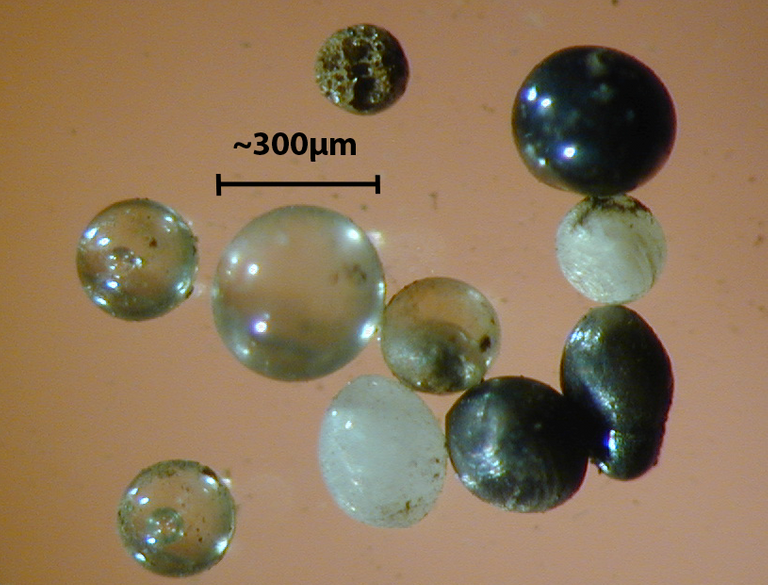
In a later section of Earth in Upheaval, Velikovsky quotes Pettersson again:
The bottom of the seas and oceans also contains evidence that the earth was showered with meteorites on a very large scale. In many places the bottom consists of red clay. Samples of the red clay from the central Pacific showed a “surprisingly high content of nickel,” and also a high content of radium, though the water of the ocean, is almost completely free of these elements. [Footnote: Pettersson, “Chronology of the Deep Ocean Bed,” Tellus (Quarterly Journal of Geophysics), I, 1949.] (Velikovsky 96)
The quoted phrase, surprisingly high content of nickel does not appear anywhere in Pettersson’s 1949 article Geochronology of the Deep Ocean Bed (which Velikovsky has again misnamed). Petterson does not even mention nickel, though he does mention “the remarkably high content of radium in certain abyssal sediments, especially in the Red Clay and the Radiolarian Ooze, discovered already by JOHN JOLY” (Pettersson 1949:1). Velikovsky actually took this phrase from a later article, Exploring the Ocean Floor, which Pettersson wrote for the popular magazine Scientific American:
There has been a great deal of interest in the surprisingly high content of nickel found in our central Pacific red-clay cores by H. Rotschi of France. Nickel is very scarce in sea water; there is only about one part of nickel in 10 billion parts of water. In a central Pacific red-clay core the proportion is 300 to 700 parts of nickel to a million, a concentration very much greater ...
It has been suggested that the high nickel content of these slowly deposited sediments is derived from volcanic lava, or basalt, emitted over the deep ocean floor. Recently, however, S. Landergren of the Geological Survey in Stockholm made a spectrographic analysis of basalt and found it to contain only modest amounts of nickel. It is tempting to assume quite a different origin for the abyssal nickel: meteoric dust. This extra-terrestrial material settles from the billions of meteors that enter the earth’s atmosphere daily and usually burn to dust high in the stratosphere. It is known to have a very high nickel content averaging about two per cent. The maxima of nickel content found at certain levels of our cores might then be due to very heavy showers of meteors in the remote past. The principal difficulty of this explanation is that it requires a rate of accretion of meteoric dust several hundred times greater than that which astronomers, who base their estimates on visual and telescopic counts of meteors, are presently prepared to admit. (Pettersson 1950:44)
Needless to say, this is music to the ears of a catastrophist like Velikovsky.
In the 1950s, the possibility of the cosmic origin of the pelagic red clay was widely debated. Pettersson himself co-authored a paper on the subject, which was published by the journal Geochimica et Cosmochimica Acta in 1952:
Determinations of the nickel, manganese and iron present in sediment cores from the Central Pacific have been made by microchemical methods. The results show (a) that the nickel content is high relative to that of continental rocks and sediments ...
It is tentatively suggested that this abundance of abyssal nickel may be partly derived from cosmic dust settling over the earth’s surface. (Pettersson & Rotschi 80)
In this paper, however, Pettersson and Rotschi adopt a position much more in line with uniformitarian orthodoxy:
Assuming that the whole of this nickel is of cosmic origin and that the distribution is uniform within the time-span involved, the total accumulation of the element to the whole surface of our planet becomes 40 x 1012 g per 1,000 years or 40,000 tons per annum. Ascribing an average nickel content of 2% to the cosmic dust, the latter figure has to be multiplied by 50 in order to reach the total contribution of extraterrestrial matter to the earth in the course of one year which gives 2,000,000 tons. Comparing this figure with that of 1,800 tons which was derived from meteor counts according to WATSON, the difference seems disconcerting for the cosmogenic hypothesis.
It was therefore thought desirable to submit the results to authorities on meteors and cosmic dust from interplanetary space. Dr. F. WATSON, in a private communication to one of the writers, states that for various reasons, the figure based on meteor counts can only be taken as a lower limit for the amount of material actually deposited on the earth’s surface, and that the true figure may well be higher by one, or even two, powers of ten. Dr. F. WHIPPLE, of the Harvard Observatory, very kindly sent the writers a typescript copy of an unpublished paper on “The theory of micrometeorites.” In this paper he discusses the possibility of very small particles, a few μ or less in diameter, penetrating the atmosphere and being deposited on the earth without being heated to incandescence by aerial friction. Dr. WHIPPLE expresses the opinion that the total mass of these invisible micrometeorites may be 10,000 times greater than that of the visible meteors. Dr. ÖPIK, of the Armagh Observatory in N. Ireland and formerly of the University of Tartu and the Harvard Observatory, had noticed the results published in a letter to Nature and had the kindness to send the writers a typescript copy of a new paper. In this most interesting work, Dr. ÖPIK discusses the total quantity of cosmic dust present in interplanetary space and which is responsible for the zodiacal light. He concludes, from his calculations, that the total quantity of such dust swept up by the earth approaches the value obtained from this study of the nickel in deep-sea deposits and may, with certain assumptions on the composition of this dust, give very close agreement. Dr. ÖPIK, in a personal communication to one of the present writers, stresses the astronomical importance of this research on the deep-sea deposits and the desirability of it being extended to still more material.
These converging opinions from three authorities on meteors and interplanetary dust encourage the view that the main part of the nickel discovered in the deep-sea sediments may be of cosmic origin. (Pettersson & Rotschi 88-89)
Pettersson remained deeply interested in this subject for the remainder of his career. After retiring from his Chair at Gothenburg in 1956, he took up a professorship in geophysics at the University of Hawaii, where he continued his studies into meteoritic dust. His last two papers, published in 1960 and 1961, were The Accretion of Cosmic Matter to the Earth and The Frequency of Meteorite Falls throughout the Ages. He died in Gothenburg in 1966 at the age of 77.
We will return to Hans Pettersson and the red clay when we come to investigate Chapter 7, Section 5, The Floor of the Seas.
And that’s a good place to stop.
References
- George Brown Barbour, Recent Observations on the Loess of North China, The Geographical Journal, Volume 86, Number 1, Pages 54-64, The Royal Geographical Society (Institute of British Geographers), London (1935)
- Rollin Thomas Chamberlin, The Origin and History of the Earth, in Forest Ray Moulton (editor), The World and Man as Science Sees Them, The University of Chicago Press, Chicago (1937)
- James Geikie, The Great Ice Age, W Isbister & Co, London (1874)
- Charles Ginenthal, Physical Evidence of Global Floods: Ocean Sediments, Circumpolar Muck, Erratics, Buried Forests, and Loess, Kindle Edition, Forest Hills, NY (2016)
- John Joly, On the Radium-Content of Deep-Sea Sediments, The Scientific Proceedings of the Royal Dublin Society, Volume 11, Pages 288-294, Royal Dublin Society, Dublin (1908)
- J S Lee, The Geology of China, Thomas Murby & Co, London (1939)
- Ruth Moore, Man, Time and Fossils: The Story of Evolution, Jonathan Cape, London (1954)
- Hans Pettersson, A Swedish Deep-Sea Expedition, Proceedings of the Royal Society of London (Series B): Biological Sciences, Volume 134, Number 876, Pages 399-407, Royal Society, London (1947)
- Hans Pettersson, The Geochronology of the Deep Ocean Bed, Tellus A: Dynamic Meteorology and Oceanography, Volume 1, Issue 1, Pages 1-5, Stockholm (1949)
- Hans Pettersson, Exploring the Ocean Floor, Scientific American, Volume 183, Issue 2, Pages 42-45, Nature America Inc, New York (1950)
- Hans Pettersson & Henri Rotschi, The Nickel Content of Deep-Sea Deposits, Geochimica et Cosmochimica Acta, Volume, Pages 80-90, Pergamon Press, Oxford (1952)
- Immanuel Velikovsky, Earth in Upheaval, Pocket Books, Simon & Schuster, New York (1955, 1977)
- Sherwood Larned Washburn, Reply: An Old Theory Is Supported by New Evidence and New Methods, American Anthropologist, Volume 56, Issue 3, Pages 436-441, Arlington, VA (1954)
Image Credits
- Zhoukoudian Peking Man Site: © Mutt (photographer), Creative Commons License
- Franz Weidenreich: American Museum of Natural History, New York, Public Domain
- A Reconstruction of Piltdown Man: J H McGregor (sculptor), Wellcome Images, Creative Commons License
- Ruth Moore Garbe: © Glessner House, Fair Use
- Zhoukoudian (Upper Cave): © Sijuwj (photographer), Creative Commons License
- Casts of Human Skulls from the Upper Cave at Zhoukoudian: © Peter Brown, Fair Use
- J S Lee (Li Siguang): Public Domain
- Woolly Rhinoceros: Charles R Knight (artist), American Museum of Natural History, Library Special Collections, Negative Number 37227 (altered), New York, Public Domain
- A Striated Boulder of Jurassic Sandstone from the Datong Basin, Shanxi, China: J S Lee, The Geology of China, Page 372, Figure 80, Public Domain
- The Chinese Loess Plateau in Shanxi Province: © Xinhua News Agency, Fair Use
- Datong Basin in Shanxi Province: © Visual China Group, Fair Use
- Daye Lake, a Glacial Tarn on Mount Taibai in Shaanxi Province (Left): © Shedous, Creative Commons License
- Daye Lake, a Glacial Tarn on Mount Taibai in Shaanxi Province (Right): © Joseph Brown, Fair Use
- The First Bend of the Yangtze River: © Fabio Nodari, Fair Use
- Tianjin (Tientsin): © Netopyr-e, Creative Commons License
- Red Loam and Yellow Malan Loess in Yushe County (Shanxi Province): © Richard H Tedford, Zhan-Xiang Qiu & Jie Ye, Fair Use
- Chinese Loess Plateau (Pleistocene Epoch): Copyright Unknown, Fair Use
- Rollin Thomas Chamberlin: © 1970 National Academy of Sciences, Washington DC, Fair Use
- Hans Pettersson: University of Gothenburg, Public Domain
- Albatross: University of Gothenburg, Public Domain
- Cosmic Spherules: © Shaw Street, Creative Commons License
